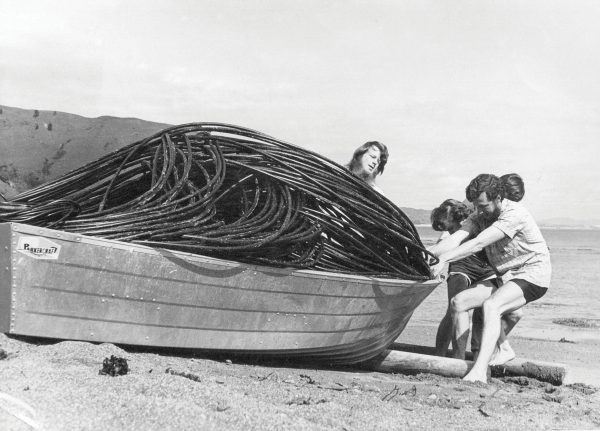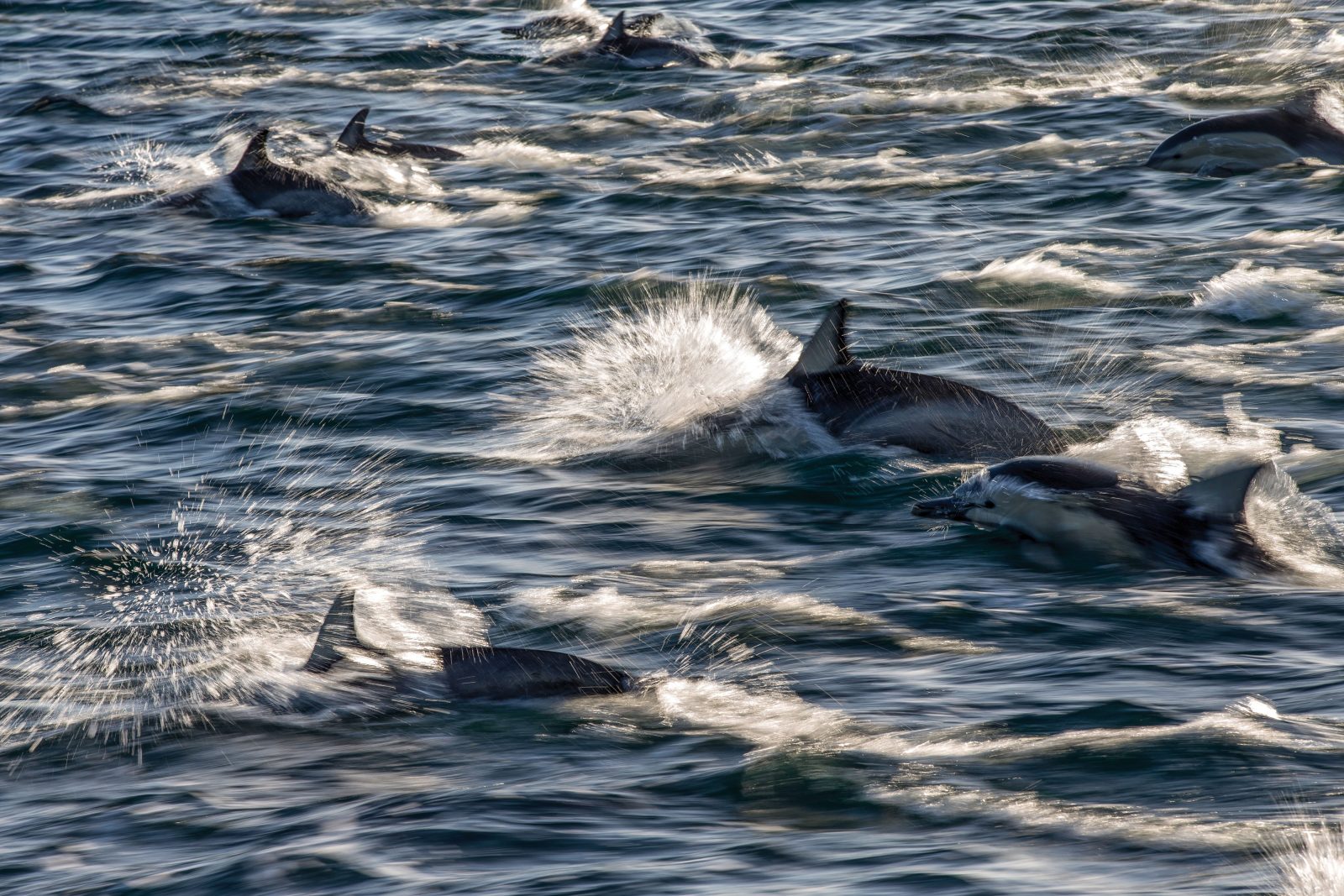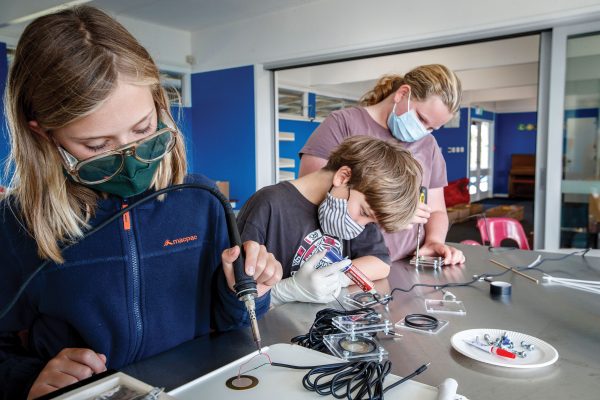
The undersea orchestra
A symphony is taking place beneath the waves, as many different animals call to each other, scare off predators, stun their prey, or munch on algae. What happens when humans drown them out?
Boing, thwop, muah, boop, scrapey-scrapey, click. Pop, growl, flub, crunch, wibber-wibber, snap. The French scuba-diving pioneer and underwater filmmaker Jacques Cousteau called his 1956 Oscar-winning ocean documentary The Silent World, but that couldn’t be further from the truth. Was Cousteau so distracted by the wonders he saw that he forgot to use his ears?
It’s not just the roar of the surf, the scatter of rain, the clinking of pebbles and the swoosh of kelp fronds. Crowds of kina crackle at dusk and dawn as they scrape algae from the rocks. Humpback whales teach each other songs. John Dory bark like dogs (and no one knows why). New Zealand bigeyes—small, nocturnal reef fish—make rhythmic pops in the dark to help them stay together as a school. Snapping shrimps clap their oversized claws to stun their prey and, where they are numerous, the sizzle of white noise helps young fish and invertebrates find a reef to settle on.

But humans are bringing jackhammers to the concert hall. More than two millennia before Cousteau’s undersea adventures, Aristotle noticed that sound could be heard in water as well as in air. In 1490, Leonardo da Vinci lowered a tube over the side of a boat and observed that ships could be heard over great distances underwater. The advent of engines during the Industrial Revolution made vessels much, much noisier than the sailing ships of da Vinci’s day. But it’s only recently that scientists have begun quantifying just how much this noise has changed the ocean environment.
In the past 50 years, anthropogenic noise—sound generated by human activities—has increased 32-fold along major shipping routes. The air guns used in seismic surveys to detect oil and gas deposits beneath the seabed send powerful pulses of sound through the water, as do—on a smaller scale and at higher frequencies—the fish-finding devices used by commercial and recreational fishers. Trawling, dredging and dynamite fishing create noise, too, while recreational boats add the collective hum of their motors. And every post hammered or drilled into the seabed to make a wharf, jetty, bridge, marina, boat ramp or wind-turbine platform increases the din.


At the same time, scientists are listening to the ocean more closely than ever before. Advances in hydrophone hardware and machine learning are helping us to eavesdrop on some of the sea’s soundscapes. Experiments are showing how noise generated by vessels and construction affects the behaviour and lifecycles of a variety of marine animals, and how sounds can even make underwater plants suffer.
And, here in New Zealand, the boating bans enforced during the COVID-19 lockdowns gave scientists a rare opportunity to hear what the sea sounds like without us.
[Chapter Break]
In March 2020, marine biologists Craig Radford, Matt Pine and Louise Wilson raced out on to the Hauraki Gulf/Tīkapa Moana in the University of Auckland boat Hawere. Their mission: to replace their hydrophones while they still could. All summer, the devices—small, waterproof microphones and recorders in one—had been recording the soundscape of the gulf—at Te Hāwere-a-Maki/Goat Island, Kawau, Tāwharanui, Tiritiri Matangi, the Ahaaha Rocks, the Noises and in the Rangitoto Channel—but their batteries were about to run out.
Five days later, New Zealand entered its first Alert Level 4 lockdown, and all non-essential boating activity was put on hold. For seven weeks, Auckland’s estimated 130,000 recreational vessels lay idle. Each day, Pine, who works remotely for the Juanes Lab at Canada’s University of Victoria, walked along Takapuna Beach with his wife and looked out at the spot where one of his hydrophones was tethered. The weather was calm and sunny. Usually at this time of year, the Rangitoto Channel would be buzzing with boats—from dinghies to cruise ships—but now, besides one container ship a day, it was empty.

After lockdown, Pine, Radford and Wilson retrieved the hydrophones and began analysing the data. Twelve hours after restrictions began, underwater sound levels in the Rangitoto Channel dropped almost threefold. By the height of the lockdown, boats could be heard only eight per cent of the day. Anthropogenic noise in these once-bustling urban waters was suddenly more akin to a summer’s day in the Arctic Ocean.
With the persistent buzzing of motors gone and calm weather reducing the interference of wind and rain, a symphony of other sounds emerged. In one brief recording, Pine identified a Bryde’s whale calling, dolphins whistling and clicking, a seal barking, fish popping and grunting, invertebrates climbing over the hydrophone, a distant ship out in the Pacific Ocean, and waves crashing on island shorelines three kilometres away.
The lockdown had resulted in a kind of accidental experiment in turning down the volume—an unprecedented chance to find out what the persistent human noise might be masking, and how much people had altered the gulf’s natural soundscape.
[Chapter Break]
Sound travels further and more rapidly in the ocean than any other sensory signal, so numerous animals have evolved to rely on it to navigate, find food, woo mates, coordinate spawning, avoid predators, keep track of their offspring, intimidate rivals, or find a new home. Some crab larvae even speed up their metamorphosis when the soundscape suggests they’re close to a suitable habitat.
“They evolved in a quieter ocean without anthropogenic noise,” says Denise Risch, a marine mammal ecologist with the Scottish Association for Marine Science.
Think of how disruptive a thick fog is to sight-dependent humans, and that comes close to the effect noise pollution has on marine animals.
- Snapping shrimps crackle, John Dorys croak, big eyes make popping sounds while crayfish grind like a güiro.
Chronic noise pollution can mask the crucial conversations animals have with each other and the surrounding environment. The lockdown study clearly showed that this masking is happening in the Hauraki Gulf. Pine and his colleagues calculated that, for every 10 per cent decrease in daily vessel noise, the communication range increased by anywhere from 47 to 519 metres for bottlenose dolphins and 13 to 18 metres for bigeye fish.
At the Ahaaha Rocks, north of Waiheke, the range of dolphins’ calls and whistles increased from about three kilometres to nearly four kilometres. In the Rangitoto Channel, fish communication improved even more dramatically. Before lockdown, bigeyes could only hear each other from a few metres away. Now, without boats, their acoustic range soared to 155 metres. If bigeyes have to swim closer together to communicate, they may miss feeding opportunities. And with limited hearing, they may fail to recognise the approach of a predator.
As well as driving animals away from critical feeding or breeding areas—thus increasing the energy they expend in travelling—noise also makes their lives more stressful.
Stress is difficult to measure, but can have wide-ranging effects, says Risch: “You might not die because you’re stressed for a week or so. But if you’re stressed continuously, over your lifetime, you might have a shorter lifetime or you may reproduce less. So, over time, [there are] population consequences.”
One study of pilot whales in the Canary Islands found that the calves ate less when noisy petrol-powered vessels were near. When whale-watching boats approached the animals, the time the calves nursed for plummeted by 81 per cent, while their mothers spent 29 per cent less time at rest. Boats with electric motors, which are quieter, had no effect on the whales.
Marine species don’t even have to have ears to be negatively affected by noise. In 2021, scientists played tapes of low-frequency anthropogenic sounds to tanks of Neptune grass, a type of seagrass native to the Mediterranean. After just two hours, the plants suffered acute damage to gravity-sensing organs in their roots and rhizomes, which affected their ability to take in nutrients and store carbon.
[Chapter Break]
Louise Wilson loves sounds so much she collects them. She takes a portable audio recorder with her on holidays and tramping trips to capture what she calls “acoustic postcards”, sometimes even weaving the birdsong and cityscapes into musical compositions.
Her doctoral research at the University of Auckland focused on detecting small-boat sounds and their impact on the soundscape of the gulf. Most of the recent global studies into marine noise pollution have focused on commercial shipping in the open ocean, because its impacts are easiest to count and track: all ocean-going ships over 300 tonnes are tracked by satellites and from shore, and the data are publicly available.


At Astrolabe Reef/Ōtāiti in the Bay of Plenty, preliminary results from a study by the University of Waikato’s Jenni Stanley suggest that the hum of container ships is ever-present, due to vessels entering the busy port of Tauranga.
But in shallow waters near cities, like the Hauraki Gulf, small recreational boats likely present a greater threat to marine ecosystems, says Wilson. Boats of various sizes with different types of engines travelling at different speeds through diverse coastal habitats produce noise at multiple frequencies, and therefore affect a wider range of animals. And while a single motorised dinghy makes a small contribution on its own, thousands of them add up. Boats do not have to be registered or permitted, so the exact number in use on the Hauraki Gulf is unknown—but boat sales have reached record highs during the pandemic, and in 2021, a Maritime New Zealand survey found that half of all New Zealanders were involved in recreational boating (although this figure also includes kayaks).
Using a combination of hydrophones and cameras as part of her doctoral research, Wilson showed that boat noise in the gulf was near-constant. Boats were present almost every day at all sites she studied—Goat Island, Tāwharanui, Kawau, Tiritiri Matangi and Ōtata in the Noises—and the low-frequency noise they emitted made the entire soundscape louder. The effect was most pronounced during the summer, which is also when many animals, including bigeyes, breed. Wilson recorded a baseline soundscape in each location, which varied considerably with the time of day, season, lunar cycle and ferry timetable, highlighting “the complex interplay of biophony, geophony and anthrophony”—to us mortals, that’s animal sounds, environmental sounds, human sounds—“which form a habitat’s soundscape”.
[Chapter Break]
I grew up knowing the ocean was a noisy place.
Hydrophones were first used in New Zealand by the Navy, listening for the approach of enemy submarines off Aotea/Great Barrier Island during World War II. But one of the first people to record the noises made by marine animals was my father, Jo Evans.
In the early 1970s, he was a master’s student at the University of Auckland’s Leigh Marine Laboratory, studying the physics of underwater sound. Colleagues in the physics department built a hydrophone—a cylinder about the size of a paper-towel tube—that could hear a wide range of frequencies.
In his scuba gear, Dad secured the hydrophone to an underwater tower off Goat Island. A 600-metre-long cable supplied the device with power and transmitted the sound waves, which were captured on reel-to-reel tape recorders back at the lab. (The cables were the weak point—storms were constantly ripping them from the seabed.)

Navy researchers suggested Dad listen for a mysterious “dusk chorus” heard at Great Barrier. Sure enough, it was there at Leigh, too—an increase in the background noise, a sound like fish frying, lasting for about 20 or 30 minutes every evening at dusk. Later students found that kina made the noise: thousands of them, scraping away at the reef with their five-pointed star-shaped mouthparts, the rasping sound ringing their spherical shells like bells.
In the half century since Dad listened to sea eggs, it’s become much easier to record and analyse the songs of the sea. The most important revolutions—in computing power, solid-state and cloud storage, and battery size—have happened in the past decade. Ten years ago, when Matt Pine wrote his doctoral thesis on how anthropogenic noise affects crab larvae, he used a music recorder in a waterproof case connected to a hydrophone with a car battery in it. Now, you can buy a cheap made-in-New Zealand all-in-one hydrophone and recorder that will fit into a plastic tube, and you can train a computer to sift through thousands of hours of recordings and flag the sounds you’re interested in. “You can put hydrophones all over the ocean,” says Pine.
That’s exactly what Jenni Stanley has done. She has installed hydrophones at Mōtītī in the Bay of Plenty, and in Fiordland, at Hinenui/Nancy Sound, Te Rā/Dagg Sound, Tamatea/Dusky Sound and Taiari/Chalky Inlet. When she dives, she can hear a little of the undersea orchestra—but not much. “You’re quite deaf underwater as a human. Your outer ear canals are flooded, and you have no sense of direction.”

It takes the audio recordings to reveal the soundscape. “[They blow] my mind—the sheer magnitude of how many biological beings are making sound down there in their general life. It’s just wondrous.”
Every time she opens an audio file, Stanley hears something new. “There are sounds where I can say, ‘Okay, that’s a fish. That’s a marine mammal. That’s an invertebrate of some description.’ But then there are always sounds that you hear and you’re like, ‘I have no idea…’”
Lots of hydrophones mean lots of data—more than researchers can keep up with. Stanley, Radford and other international scientists hope to assemble an open-access global library of underwater biological sounds—charmingly dubbed GLUBS—where researchers, citizen scientists and schoolchildren alike can upload their recordings for future analysis. “The volumes of data we’re getting are just astronomical,” says Radford. “We need a place to store this stuff.”
[sidebar-1]
Something the machines can’t do is identify which animal is making what sound. As ever, that requires careful observational work in the field and the lab. But a library will allow scientists to more easily compare their recordings with others, and serve as a reference for the calls and noises made by different species. The large number of sounds will enable them to train artificial intelligence to distinguish marine life from noise. And as machine learning improves, scientists are also hopeful that computers could use the soundscapes themselves to assess the health of ecosystems, by listening for the presence—or absence—of individual animal instruments, or changes to the symphony over time.
“There’s so much knowledge and useful data there that we just haven’t quite grasped yet,” says Stanley. “We’re just constantly at the frontier of discovery.”
[Chapter Break]
What we do know is that human noise is negatively affecting the lives of ocean animals. So now that we can hear the problem, what can be done to fix it? Unlike other kinds of pollution—from plastics to chemicals to greenhouse gases—noise has one great advantage. If you turn the sound off, it’s gone in an instant, with no lingering effects. Business as usual, however, will lead to an ever-increasing cacophony and a resulting decline in the health of ocean ecosystems. (According to Ports of Auckland, vessel traffic in the Hauraki Gulf is expected to increase by 70 to 75 per cent in the next 20 years.)
In 2021, international researchers including Radford surveyed 500 studies of marine noise pollution and recommended some solutions in an article in the journal Science. Propellors are responsible for about 85 per cent of shipping noise; redesigning them to avoid cavitation—the formation of small bubbles in the water—would improve fuel efficiency while dramatically reducing shipping noise. So would transitioning to electric motors. But both solutions are costly, and there are no national regulations or international agreements encouraging ship-building companies to transition.

In the meantime, the article’s authors say, authorities should consider slowing boats down or diverting shipping lanes away from areas where animals feed or breed. In the Hauraki Gulf, the 10-knot voluntary speed limit introduced for container ships in 2013 to avoid striking Bryde’s whales may also have had a positive effect on underwater noise. A 2018 University of Auckland study found that, when ships keep to the speed limit, they produce less noise and allow Bryde’s whales to hear each other better—but, even then, when the ships are directly overhead, the animals’ ability to communicate drops by 99 per cent.
Internationally, engineers are working on developing “bubble curtains” that reduce the noise from pile-driving during offshore construction, and “marine vibrators” as an alternative to seismic air guns. In New Zealand, a 2013 voluntary code of conduct encourages seismic surveyors to take measures to reduce their impact on marine mammals. (A planned review of the code was put on hold after the government announced in April 2018 that it would not grant any new permits for offshore gas and oil exploration.)
Regulations in marine protected areas need to catch up with research, say the scientists. Marine reserves aren’t pristine if they’re getting blasted with boat noise—so speed limits inside their borders are a no-brainer, says Stanley.
“I think we’re definitely behind the game with underwater noise. I want the soundscape to remain healthy throughout, but marine reserves are a good place to start.”
Marine reserves are administered by the Department of Conservation, but spokesperson Kirstie Knowles says DOC isn’t sure if it has the legal standing to impose speed limits. (In addition, she says, limits would be challenging to enforce given the small number of DOC rangers spread around 44 marine reserves.) Local authorities can make bylaws to restrict vessel speed in certain areas, as Environment Southland has already done in Patea/Doubtful Sound.
Radford hopes that one day, hydrophones themselves could act as speed cameras, using machine learning to detect and report telltale sounds of speeding boats or night-time illegal fishing activity.
Preserving the undersea orchestra is within our grasp—if we decide to do it. When humans went quiet during the lockdowns, nature was in full voice. Despite the many challenges faced by the Hauraki Gulf—the overfishing, the overheating, the sedimentation, the kina barrens—the sea is still singing, if we shut up long enough to hear it.























